Terracotta Warriors and Horses Museum – One of the Eight Wonders in the World
What are the Terracotta Warriors?
China Terracotta Army, aka Terracotta Warriors and Horses Museum, is a complex of thousands of life-sized terracotta statues of soldiers, chariots and horses. An important part of the Mausoleum of Qin Shi Huang, it is the mirror of the real troop of the Qin Dynasty and was constructed to guard Qinshihuang (the first emperor in Chinese history) in his afterlife.
These terracotta sculptures in the pits are so vivid that you may feel they were created by uncanny workmanship. Terracotta Army was listed as a World Cultural Heritage Site by UNESCO in December 1987. It was also praised to be the Eighth Wonder of the World and one of the great discoveries in archaeological history in the 20th century, making it a must-see for any Xian tours.
Quick Terracotta Army Facts
- In Chinese: 秦始皇兵马俑
- Location: in Lintong District, Xi’an, Shaanxi Province; about 40 kilometers (24.9 miles) northeast of Xi’an downtown
- Type: World Cultural Heritage, Historical Site, Specialty Museum
- Period: Qin Dynasty (221-207 BC)
- When it was unearthed : In March 1974
- Time Needed: about 3 hours
- Opening Hours: March 16th–November 15th (Peak Season): 8:30-17:00; November 16th–March 15th the next year (Off Season): 8:30-16:30
- Ticket: RMB 120 per person in low season (Dec. 1 – Feb. 28), CNY150 per person in high season (March 1 – Nov. 30)
- Highlights: the Eighth Wonder of the World; vivid life-size terracotta warriors; exquisite bronze chariots and horses
- Best Seasons: All Seasons
- Commended for: history lovers, Chinese culture lovers

What to See in the Terracotta Warriors and Horses Museum
There are three major pits for the Qin Amy of Terracotta Warriors China, covering over 20, 000 square meters (5 acres) in total. Nearly 8,000 pieces of terracotta warriors have been unearthed from the three pits, all being the same size of a real man and horse. Meanwhile, the bronze chariots and horses, and Qin weaponry are also very stunning to see. Usually, 3 hours is recommended to explore the four main exhibition areas, which are the Exhibition Hall of the Bronze Chariots, Pit 1, Pit 2, and Pit 3.
No.1 Pit of Terracotta Army- the largest of the three pits
In No.1 Pit, apart from the life-size terracotta warriors, chariots and horses, bronze swords, hooks, crossbow machines, halberds and so on have also been unearthed. At the east end of this pit, there are 210 terracotta warriors in different facial expressions, dress styles, and hairstyles, lining up in three rows, like the forward force on standby. Behind that, it is the main part composed of 6000 armored terracotta soldiers, holding long weapons such as a spear, dagger-ax, and halberd. They lined up with 35 chariots in a 38 rows. On both north and south sides, there is a row of terracotta guard warriors to prevent the side from being attacked.
The warriors and horses in this pit are neat with complete equipment, which are the expressive representation of the mighty army of Qin Shi Huang.
Excavations show that the wooden structure of the No. 1 pit is a frame-type structure composed of tifu – pillar – Fangwood – shed wood, which is technically primitive compared with the chamber type composed of bedding wood – floor – pillar – chamber wood – shed wood. Therefore, the burial pit of terracotta warriors and horses should be a group of burial pits built earlier in the cemetery.
No.2 Pit of Terracotta Army – with more kinds of warriors
On the northeast side of the No.1 Pit is the No.2 Pit, 96 meters (105 yards) long from east to west and 84 meters (92 yards) wide from north to south. The layout of the terracotta troop is more complicated and the types of terracotta warriors are more complete, including standing terracotta archers, kneeling terracotta archers, terracotta warriors leading the horses, terracotta infantry, and cavalry. Totally, there are more than 1,300 terracotta warriors and horses, more than 80 chariots, and tens of thousands of bronze weapons in No.2 Pit.
The warriors, light chariot soldiers and cavalry figures unearthed from the second pit of Terracotta Warriors Museum show for the first time the image data of ancient cavalry, light chariot soldiers and archers 2200 years ago. It is of great significance in the study of ancient military history.
No.3 Pit of Terracotta Army – the smallest, constitutes command post
No.3 Pit is 25 meters (27 yards) from the west end of No.1 Pit, with an area of about 520 square meters (622 square yards). It’s the smallest out of the three pits, but it hadn’t been completed. There is a chariot in front of the door with 68 terracotta soldiers inside. Judging from the layout, No.3 Pit seems to be the general headquarters, commanding the whole army.
It provides valuable research materials for the study of the shape, occupation and battle ceremony of the ancient Chinese headquarters, the command system and the clothing and equipment of the dependent uniforms.
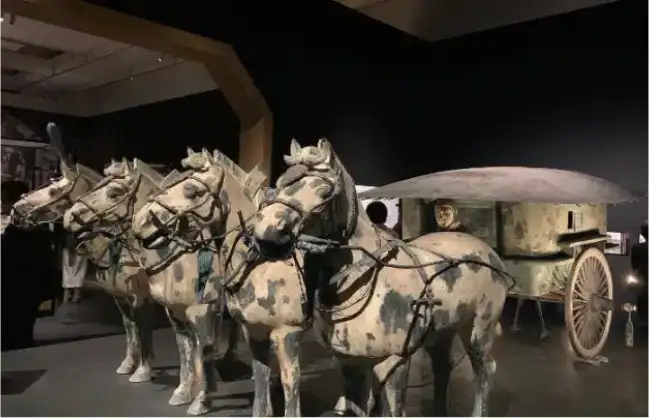
Bronze Chariots and Horses Exhibition Hall of Terracotta Warriors Museum
If you want to see more about the chariots and horses, the Exhibition Hall next to No.2 Pit will feast your eyes. You can witness the bronze chariots, bronze horses, and various Qin weapons in a close distance.
In December 1980, archaeologists excavated two large painted bronze chariots with horses on the west side of the Mausoleum of Emperor Qin Shi Huang. This is an earlier discovery of the large and well-preserved bronze chariots. There are four horses driving in front of each chariot, and a terracotta figurine that drives the chariot. The chariots and horses were lifelike and beautifully decorated, and a large number of gold and silver items were used as ornaments and components. They are known as the Best of Bronzes.
How Many Terracotta Warriors are There? How Tall are They?
As of 2007, there are over 8,000 terracotta warriors have been unearthed from the tomb of the first Qin emperor, together with 130 chariots with 520 horses, and 150 cavalry horses, represesting the armies of Qinshihuang. All the warriors are in life-size, vary in height, hairstyle, and facial features.
Generally, most warriors are 180-190 cm in height, the highest ones can reach to 200 cm. But, these height data are measured with their base at the foot and hairdressings included. The net heights of these warriors are similar to the modern people, ranging from 170 cm to 180 cm.
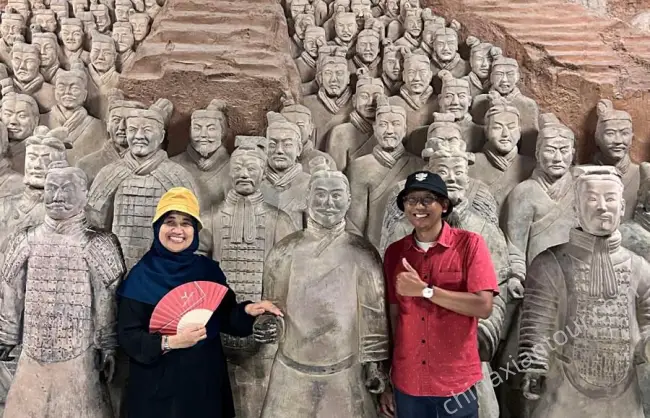
Recommended Xian Tours including the Terracotta Warriors and Horses:
For most people who travel in Xian, no matter the duration of their planned trip, visiting the Terracotta Warriors and Horses Museum should top their Xian tour bucket list. Below are 5 of our most recommended Xian Tours with the Terracotta Warriors:
- 3 Days Xi’an Private Trip: History Exploration & Tang Costume Experience
- 4 Days Xian Classic Tour with Mt. Huashan
- 7 Days Xian In-depth Culture Tour
History of the Terracotta Army
When were the Terracotta Warriors made?
This underground army was designed to guard the mausoleum of China’s first emperor – Qin Shi Huang, who unified China in 221 BC. According to archaeological data, these warriors were made from 246 BC to 208 BC, and the construction of the mausoleum involved over 700,000 conscripted workers, and lasted for about 40 years.
Why the Terracotta Army was built?
The terracotta soldiers were related to the change and development of the burial rites in ancient times. In slave society, the rulers wished to live a luxurious life after their death in another world as much as they enjoyed during their lifetime, so sacrificial offerings and some other articles for use were buried for the dead. Burying a lot of living slaves was also in great vogue among the royal families and lords. In the Spring and Autumn Period (770-476 BC), the living slaves were replaced by the terracotta figures gradually. Later in the middle and late Warring States Period (about 475-221 BC), terracotta figures came to be rife for the burial objects.
The Terracotta Warriors and Horses is not only a component part of the Qin burial system but reflects an aspect of the Qin culture as well. Such a Terracotta Army showed the power and strength of the country at that time.

Who made the terracotta warriors?
The Qin Shi Huang’s Tomb, including the terracotta warriors, was designed by Li Si, then prime minister of the Qin Dynasty, and supervised by General Zhang Han. It took 39 years to build and 720,000 people were recruited. At its peak, the number of people who built the tomb was nearly 800,000, equivalent to eight times that of the Pyramid of Khufu.
The craftsmen who made the terracotta warriors were a group of potters in the lower social strata of the Qin Empire. Some of these potters came from the palace pottery workshop, and some came from the local pottery workshop. There are 80 names of potters found on the terracotta warriors and horses, all of whom were excellent potters with rich practical experience.
What were the Terracotta Warriors made of?
The material for the making of terracotta warriors and horses was the yellow soil and white quartzite gravel taken from the northern foothills of the Lishan Mountain. After sieving and washing, something impure was removed and the soil was then ground into fine granules. After mixing up with a suitable amount of water and yellow earth, it was churned and pounded into a mold-clay of neither soft nor hard. Then molding was the main step in the making process.
The Terracotta Army makers and sculptors combined molding and sculpting together, made them part by part, and then fixed them up into a whole piece. Afterward, they were put into the kiln to be fired and painted when taken out of the kiln. With regard to the minute parts of the terracotta figures, methods like sculpting, molding, kneading, patching, carving, painting, and so on were used in turning them out.
To make the terracotta warriors morn stable for better safekeeping, the lower parts of the figures were made solid and heavier while the upper parts hollowed and lighter. For instance, the feet and legs of terracotta figures were made solid with the belly and arms hollowed. The terracotta horses were made in the same way. Particularly, every figure was made on a square board so that the space contact with the ground was widened; thereby the center of gravity as well as the figure was more stable.
Establishment of the Museum
To protect and preserve these rare relics, the Terracotta Warriors and Horses Museum was built on the very site of the No. 1 Pit as approved by the State Council in 1975. The museum was brought to completion in 1979 and opened to visitors on October 1st the same year.
When and How Were the Terracotta Warriors and Horses Discovered?
In March 1974, a farmer of the Xiyang Village, Yanzhai Township, Lintong District dug a well in the south of the village, and several broken terracotta warriors in life-size were found. After the excavation by the Shaanxi Provincial Archaeological Team, the terracotta warriors and horses have reappeared. This is how the No. I Pit was discovered. Later in 1976, No. 2 and 3 Pits were excavated one after another.
Interesting Facts about Terracotta Warriors and Horses
The construction of Terracotta Amry lasted for 39 years
The Mausoleum of Emperor Qin Shi Huang, including the terracotta warriors and horses, had been constructed for around 39 years since the he took the throne of the Qin State when he was 13 years old. More than 100,000 people were recruited from various places for the construction. To the unification of China and even his death, it hadn’t been completed. It was forced to stop in 208 BC because of the peasants’ uprising.
It was once damaged at the end of the Qin Dynasty
At the end of the Qin Dynasty, it was wartime with endless battles and uprisings. In that period, the terracotta army was buried after being flooded. There are some traces in the pits to prove what it suffered. Xiang Yu, the leader of one most powerful forces, was suspected of setting the fire. He captured the capital of the Qin Dynasty and fired the Epang Palace. But some scholars think it isn’t him who did that.
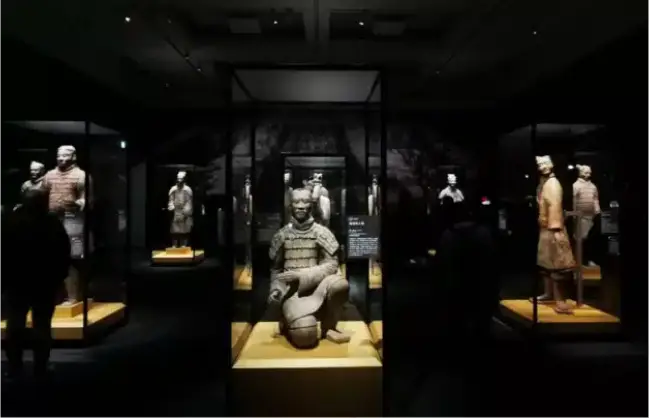
Each soldier of Terracotta Amry is not the same
Each of the terracotta warriors and horses is unique. In particular, every terracotta warrior has a unique face with different facial features. How amazing it is! Thus, the terracotta army was doubted to be made with real men; but it’s not true. The incredible workmanship deserves its great honor and reputation.
The Terracotta Warriors and Horses used to be colored
Do you know the terracotta warriors and horses turned out to be colorful? It is reported that the terracotta warriors and horses were in bright colors when they were made. However, due to the fires, floods, and natural erosions underground in the about 2,200 years, more than 95% of them have fallen off. Some colorful ones lost their colors only a few minutes after being unearthed and exposed to air. The technologies during the excavation time could not solve this problem, which is one of the reasons why the Mausoleum of Emperor Qin Shi Huang has not been excavated on a large scale.
There is a No.4 Pit
A few people know that there is also a No.4 Pit between No.2 and No.3 Pits. However, there is no terracotta warrior or horse but the backfilled soil. It is supposed that this is because the construction was forced to shut down for the turmoil of uprisings and wars.
Mysteries of the Terracotta Warriors
The mysterious green-face Terracotta Warrior in Pit No.2
There is a terra-cotta warrior kneeling in the second pit of the Terracotta Army museum has a distinctive pale green face. Does that imply that it has a unique identity or meaning?
There’s a lot of speculation. Some people think that it may be that the copper element was accidentally mixed in the production process, and after a long time of oxidation reaction, this green appearance was formed. There is also a saying that it is related to the witchcraft sacrifice popular in the Qin Dynasty. Some scholars have speculated that the clay figure with its green face may represent some kind of special sacrificial role, or it may have been green when it was made, mainly to highlight its mysterious identity.
Are Terracotta Soldiers made from real people?
Since “sacrificial burial” was a practice during the Qin Dynasty, some individuals think that the terracotta army was created by burning clay that had been sealed real people. According to an unverified historical narrative, Xiang Yu, the overlord of Western Chu, once visited the pit containing the Terra-cotta warriors and horses. He split several of the warriors to examine them, but he had no idea that the shattered warriors were actually human bones.
Of course, these warriors are not made of real people. The answer was revealed by numerous shattered terracotta warriors during the excavation. Among the shattered terracotta warriors, no human bones have been discovered. Besides, the name of the potter is printed or carved on each of the hollow terracotta warriors.
More mysteries:
- Why The Terracotta Warriors Have Single-edge Eyelid
- Who is the Real Owner of Terracotta Warriors and Horses
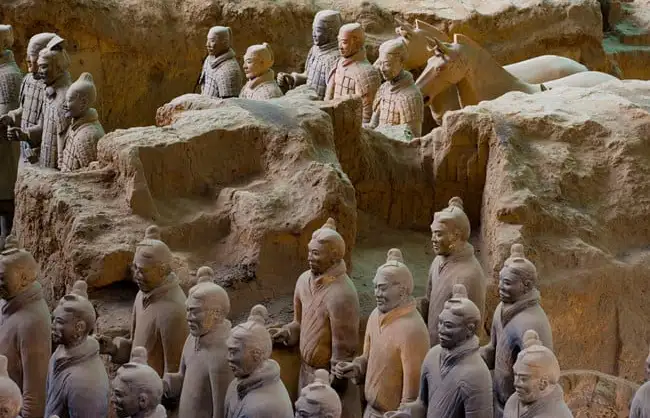
How to Book Terracotta Army Tickets?
To manage visitor flow, the Terracotta Army Museum has implemented real-name ticketing. Its official website allows anyone to purchase a ticket.
Seven days prior to the event, tickets are made available. To avoid the lines and guarantee your admission to one of the eight wonders of the world, it is advised that you purchase your ticket in advance.
Book with us the Terracotta Army tickets, as well as the best local guide, transfers, and the hands-on activity of making a mini clay warrior yourself.
How to get to Terracotta Army from Xian?
- Metro Line 1 + Metro Line 9 + Lintong Tourist Bus 613
From Xi’an downtown, you can take the Metro Line 1 first to the terminal Fangzhicheng Station, then transfer to Metro Line 9 to get off at Huaqingchi (Huaqing Palace) Station. Coming out from the Exit C and walking forward, you’ll the bus stop to transfer to Lintong Tourist Bus 613, which will take you to the Terracotta Army.
- Metro Line 1 + Tourist Bus Line 5/Bus 306
Take Xi’an Metro Line 1 to Fangzhicheng Station. Come out from the Exit B, walk north for a few distance to the Fangzhicheng Bus Station. You can find the getting-on spot of Tourist Bus Line 5 or Bus 306 in front of the bus station, which will take you to the Terracotta Army directly.
- Airport Bus Lintong Line + Tourist Bus Line 5/Bus 306/Bus 307
From Xi’an Xiyang International Airport, you can find the bus Lintong Line at T3 Terminal. Take the bus and get off at the Lintong Campus of Xi’an University of Science and Technology. Then transfer to Tourist Bus Line 5/Bus 306/Bus 307 to the destination.
China Terracotta Army Travel Tips
- The guide service in Chinese, English or Japanese are available with an extra expense.
- To protect these relics of Terracotta Army, don’t touch them. No flash when you take pictures.
- You cannot step into the pits. Remember to take a telescope or telephoto lens for your camera to watch the Terracotta Warriors and Horses more clearly.
- At the entrance of Terracotta Army site, there are sometimes enthusiastic people who will lead a wrong way for you. These men are the frauds, and you would be instructed to take the so-called shuttle bus to a false “terracotta warriors and horses pit”. Stay away from these persons and ignore them.
- In the East Square of Xi’an Railway Station or near the Fangzhicheng Bus Station, there are some fake Tourist Bus Line 5. The staffs of the real buses wear uniforms with armbands, and you need to line up in front of a sign to board the bus.
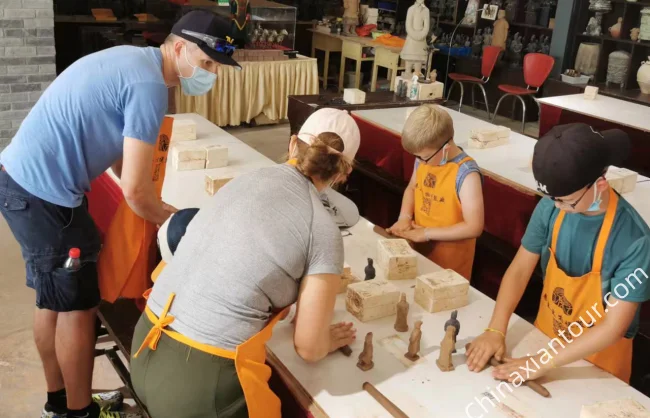
More China Tours including Terracotta Warriors and Horses:
- 2 Days Xian Terracotta Warriors Exploration Tour
- 1 Day Beijing Xian Tour by Flight
- 2 Days Shanghai Xian Tour by Air
- 10 Days Great China Tour of Beijing-Xian-Guilin-Shanghai
- 8 Days Beijing – Xian – Shanghai Highlights Tour
Find more related China Terracotta Warriors Tours.









